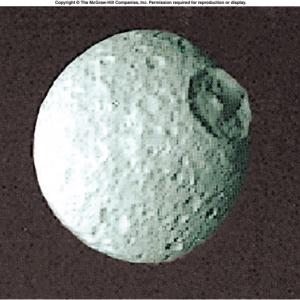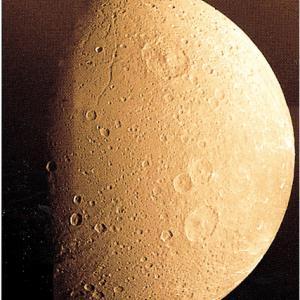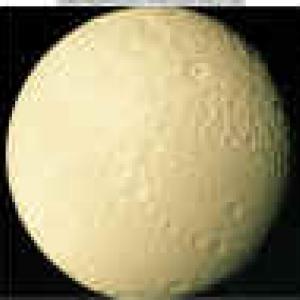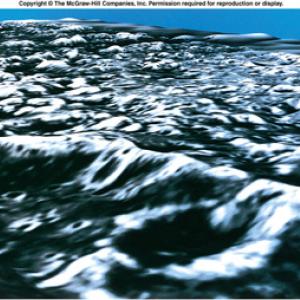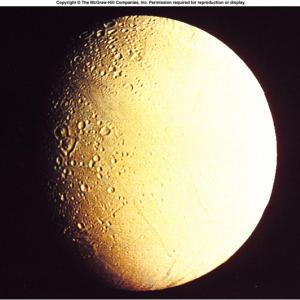College of Liberal Arts & Sciences
8A50.65 - Saturn's Moons
The pictures in order are:
- Astronomy magazine Titan globe which was produced using images from the Cassini spacecraft's Visual and Infrared mapping Spectrometer and its Imaging Science Subsystem. It also shows the Huygens' landing site.
- Mimas - Crater Herschel
- Dione
- Tethys
- Enceladus
- Gordon McIntosh, "Wind in the Solar System", TPT, Vol. 48, #2, Feb. 2010, p. 94.
- Carl Fields, "The View from Mimas", TPT, Vol. 26, #4, Apr. 1988, p. 207.
- Michael Manga, Maxwell Rudolph, "Enceladus Erupts", Physics Today, Vol. 76, #1, Jan. 2023, p. 62.
- Johanna L. Miller, "Radar Reveals New Hot Spots on Enceladus", Physics Today, Vol. 70, #5, May 2017, p. 18.
- R. Mark Wilson, "Turbulent Dissipation Sustains Eruptions on Enceladus", Physics Today, Vol. 69, #5, May 2016, p. 20.
- Steven K. Blau, "Enceladus's Subsurface Ocean Wraps the Moon", Physics Today, Vol. 68, #12, Dec. 2015, p. 25.
- Mark Wilson, "Explaining the Two-Toned Nature of Iapetus", Physics Today, Vol. 63, #2, Feb. 2010, p. 15.
- Ralph D. Lorenz, "The Changing Face of Titan", Physics Today, Vol. 61, #8, Aug. 2008, p. 34.
- Benjamin A. Black, J. Taylor Perron, Douglas Hemingway, Elizabeth Bailey, Francis Nimmo, and Howard Zebker, "Global Drainage Patterns and the Origins of Topographic Relief on Earth, Mars, and Titan", Science, Vol. 356, #6339, May 2017, p. 727.
- J. Hunter Waite, Christopher R. Glein, Rebecca S. Perryman, Ben D. Teolis, Brian A. Magee, Greg Miller, Jacob Grimes, Mark E. Perry, Kelly E. Miller, Alexis Bouquet, Jonathan I. Lunine, Tim Brockwell, and Scott J. Bolton, "Cassini Finds Molecular Hydrogen in the Enceladus Plume: Evidence for Hydrothermal Processes", Science, Vol. 356, #6334, Apr. 2017, p. 155.
- Jeffrey S. Seewald, "Detecting Molecular Hydrogen on Enceladus", Science, Vol. 356, #6334, Apr. 2017, p. 132.
- Paul Voosen, "Food for Microbes Abundant on Enceladus", Science, Vol. 356, #6334, Apr. 2017, p. 120.
- L. Iess, D. J. Stevenson, M. Parisi, D. Hemingway, R. A. Jacobson, J. I. Lunine, F. Nimmo, J. W. Armstrong, S. W. Asmar, M. Ducci, P. Tortora, "The Gravity Field and Interior Structure of Enceladus", Science, Vol. 344, #6179, Apr. 2014, p. 78.
- Richard A. Kerr, "Cassini Plumbs the Depths of the Enceladus Sea", Science, Vol. 344, #6179, Apr. 2014, p. 17.
- Michael Moyer, "Ringed Victory", Popular Science, Vol. 277, #6, June 2005, p. 82.
- Shigeru Ida, "The Origin of Saturn's Rings and Moons", Science, Vol. 364, #6445, June 2019, p. 1028-1030.
- Linda Spilker, "Cassini-Huygens' Exploration of the Saturn System: 13 Years of Discovery", Science, Vol. 364, #6445, June 2019, p. 1046-1051.
- Jennifer Lehman, "Every Single Moon Ranked", Popular Mechanics, May/June 2024, p. 24.
Disclaimer: These demonstrations are provided only for illustrative use by persons affiliated with The University of Iowa and only under the direction of a trained instructor or physicist. The University of Iowa is not responsible for demonstrations performed by those using their own equipment or who choose to use this reference material for their own purpose. The demonstrations included here are within the public domain and can be found in materials contained in libraries, bookstores, and through electronic sources. Performing all or any portion of any of these demonstrations, with or without revisions not depicted here entails inherent risks. These risks include, without limitation, bodily injury (and possibly death), including risks to health that may be temporary or permanent and that may exacerbate a pre-existing medical condition; and property loss or damage. Anyone performing any part of these demonstrations, even with revisions, knowingly and voluntarily assumes all risks associated with them.
